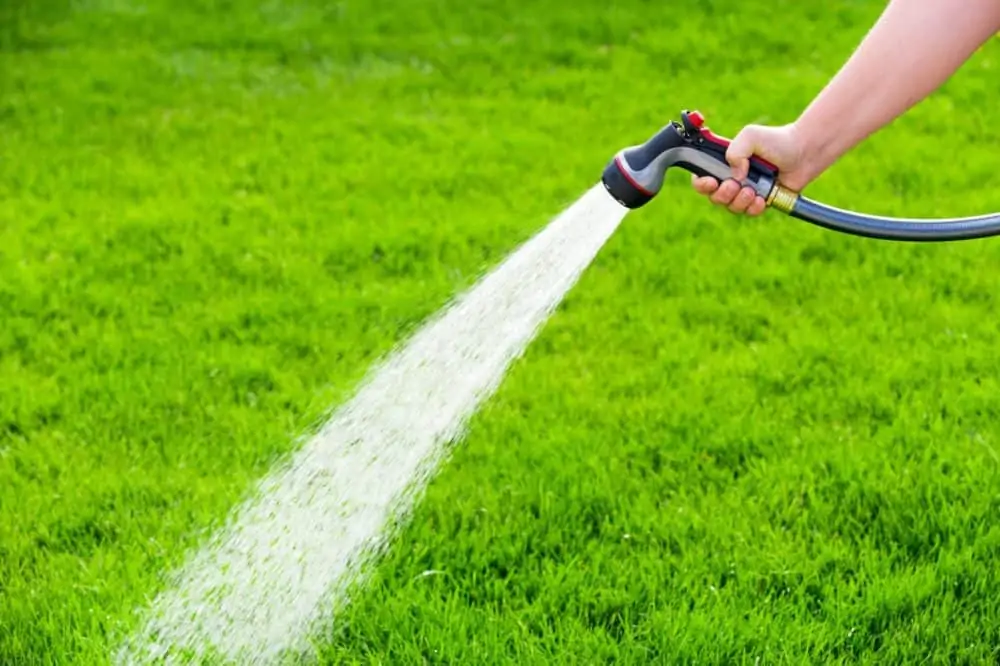We all know the importance of water for each and every living thing whether we are concerned about drinking enough glasses of water a day, whether we religiously refill our pet’s water bowl to ensure they have fresh water every hour, or even if we meticulously stick to a watering schedule for our favorite plants, the wet stuff is vital.

However, is it possible for there to be too much of a good thing? Well, that seems to be the case! Especially when it comes to grass.
In this article, we are going to be answering some of your frequently asked questions regarding the overwatering of grass, as well as helping you to identify what overwatered grass may look like.
Can you over water grass?
Yes. You can overwater grass. Whilst it is important that grass has enough hydration and moisture to grow and thrive, it is certainly possible to give it too much of this.
Overwatering grass is more common than you think and can cause all kinds of issues.
Overwatering can actually suffocate your lawn, causing the grass to develop issues such as fungus, rot, and leave it susceptible to disease and pests.
What’s more, is that it can actually have an adverse effect, causing your grass to become bare and die off, rather than thriving as you want it to.
Something that can make it even more confusing is the fact that there are many different types of grass, all of which may have different watering needs. Partner this with the fact that their needs may change with the season, and it can all get very confusing, very quickly.
It can be difficult to know exactly how much and how often you need to water your grass in order to achieve your desired luscious lawn, but we have some tips that may make this easier, no matter what type of grass you have.
When you notice the blades starting to curl this is a sure sign that your lawn needs some TLC. Water it to prevent it from becoming dehydrated.
Another sign that your lawn may need some water is if you can walk across it and see your footprints indented. A dehydrated lawn will be able to spring back into shape in the same way as a well-hydrated lawn, and so imprints can be seen clearly.
A good time of day to water your grass is in the morning, preferably before 10 am so that the sun is still low. This will give the water enough time to soak in properly, rather than being quickly dried out by the sun.
Following our tips will ensure that you do not overwater your lawn. However, if you have overwatered it, don’t fret. Just relax your watering for a few days and it will work itself out. Just be aware of any issues that may have been caused because of it such as fungus and disease and treat them accordingly.
What does overwatered grass look like?
Thankfully, overwatered grass has plenty of telltale signs. It is likely that you will be able to pick up on issues as soon as it becomes overwatered, even if you don’t yet know that overwatering was the cause.
What we mean by this is that you may identify an issue with your grass and later realize it is down to overwatering.
The telltale signs are easy to identify. Typically, the overwatered lawn will feel different underfoot. You can expect it to feel spongy, and it may even squelch if it is extremely overwatered.
Surface water and run-off are common on an overwatered lawn, so you should look out for signs of this. This will be noticeable as it displays patches of visible water.
You may also find that the grass has discolored patches of brown or yellow. This happens because the excess water leeches out all of the nutrients from the grass, causing this unsightly discoloration.
You may even find that some of the grass has thatched together. Thatching occurs when decayed and dead grass has thatched together with new grass.
This new grass often grows from the surface, rather than in the soil. This is because they have no need to root lower to the ground as there is enough water on the surface.
Another sure sign that your lawn may have been overwatered is the presence of fungus and diseases for no apparent reason. The very moist and damp ground can be a breeding ground for fungus.
Look out for the growth of visible fungus such as mushrooms, as well as some grass related diseases which present as white or red webbing.
You may also find that an overwatered lawn attracts pests of all kinds. Both fungus and pests can be treated with the required pesticides and fungicides.
